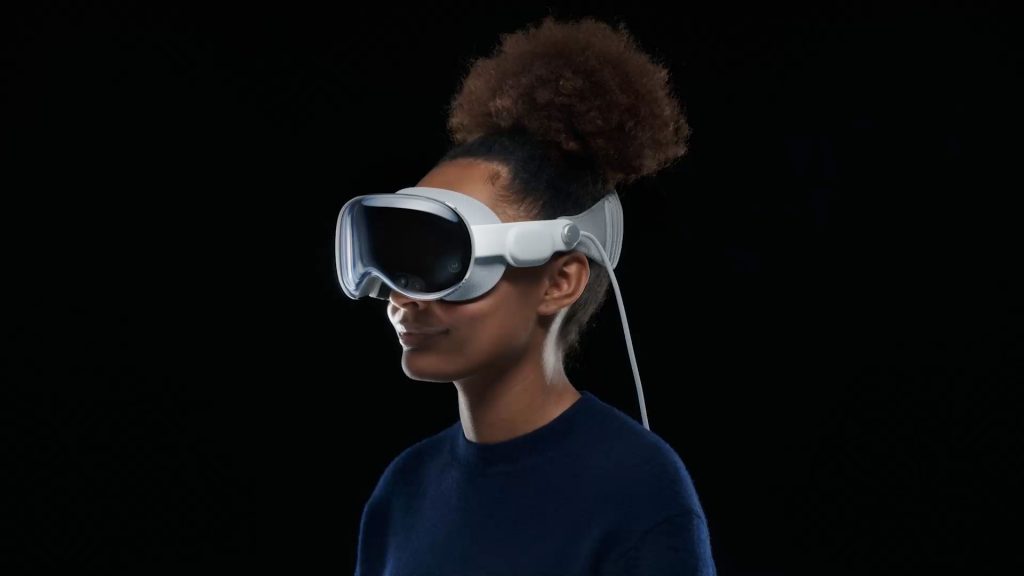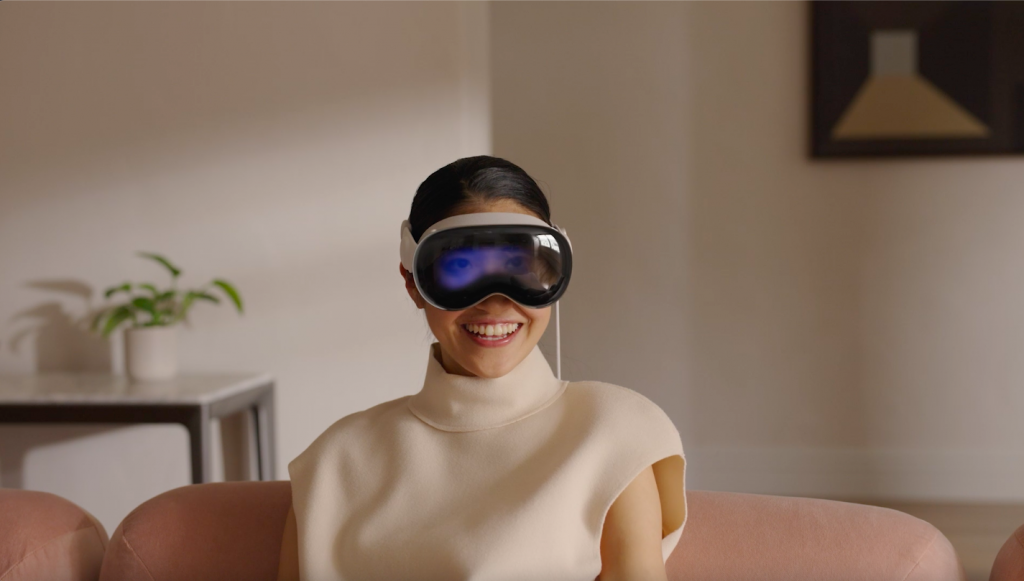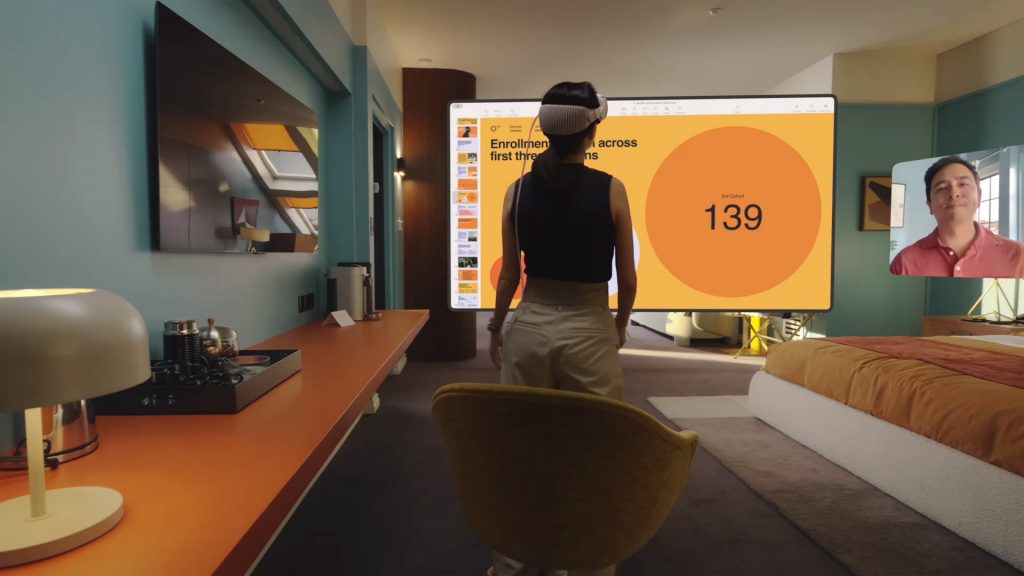The Gray Market
Apple’s Hotly Anticipated Mixed-Reality Headset Won’t Disrupt the Art World, But Could Help Optimize the Market
Our columnist weighs in on what Apple's Vision Pro will mean for the art world.

Our columnist weighs in on what Apple's Vision Pro will mean for the art world.

Tim Schneider

Every week, Artnet News brings you The Gray Market. The column decodes important stories from the previous week—and offers unparalleled insight into the inner workings of the art industry in the process.
This week, a new lens on the future…
At its Worldwide Developer Conference last week, Apple unveiled what the company hopes will be its most paradigm-shifting device since the iPhone: the Vision Pro, a mixed-reality headset designed to inaugurate the era of “spatial computing.” The announcement has already triggered an avalanche of speculation about whether and how the Vision Pro will irreversibly alter the ways we work, live, and relate to one another in the years ahead, with the implications for making and experiencing art looming large in the background.
Before the hype train barrels too far into this domain, however, I think it’s critical to triangulate any discussions about the Vision Pro with the social foundation of the art world and the membrane separating the art world from mainstream culture. Otherwise, trying to think through the device’s potential relevance (or lack thereof) will send artists and art professionals careening into the same all-or-nothing binary already cracking up too many conversations in art, tech, and everything else.
While I don’t want to bog us down in geekery, it’s important to spend a little time on the Vision Pro’s features and innovations. The reason? Anyone who only understands the Vision Pro as a sleeker, more powerful, Apple-fied answer to virtual reality headsets like the Meta Quest, or augmented reality devices like Microsoft’s HoloLens, is unwittingly close to only understanding a car as a faster horse.
I’m bringing in both of those comparison points for a reason: instead of being dedicated to either fully immersive V.R. or integrative A.R. that overlays digital elements onto physical reality, the Vision Pro can toggle from one mode to the other with the turn of a dial. This capability wildly expands its potential use cases, positioning the Vision Pro as the only headset of any kind that you’ll need or want to own.
That’s just the beginning. Somewhere in the neighborhood of 5,000 different patents were granted to Apple to bring the Vision Pro to fruition, according to Puck columnist Baratunde Thurston. For comparison, in the entire first decade of iPhone models, Apple filed for a grand total of just 200 patents for the device, per Digital Turbine. One upshot of all the proprietary technology is that, unlike many other headsets, the Vision Pro doesn’t require handheld controllers; instead, users can operate the interface and the experiences using only their eyes, hands, and voice.
What about picture quality, no doubt a critical aspect of the technology for curious artists and art pros? The Vision Pro’s image resolution is estimated to be literally 100X higher (34,000 pixels per inch) than the resolution of Apple’s first Retina display (340 pixels per inch), which the company pitched as having picture quality so crisp that the human eye can no longer distinguish digital images from reality.
And then there’s the truly trippy, borderline skin-crawly innovations. The one that has attracted the most attention (see: exasperation) is what Apple has dubbed EyeSight, a feature that digitally replicates the eyes of a user strapped into the headset and broadcasts this image onto an outer screen visible to anyone approaching in real space. Although it’s ostensibly an attempt to humanize V.R. (better to see a facsimile of where they’re currently looking than nothing at all), EyeSight has mostly been received as a dystopian farce—the manufacture of a fake a social connection so that the user doesn’t have to stop and create a real one one. If the Vision Pro ultimately goes down in tech history as a colossally expensive bust, this will be the photo used to point and laugh at its corpse until the heat death of the Milky Way:

The EyeSight feature on Apple’s Vision Pro creates a real-time digital animation of the user’s eyes when people approach. Courtesy of Apple.
But the fake eyes are a sideshow in this department. Powering the Vision Pro hardware is an adaptive A.I. model constantly working to optimize user experience. According to a long tweet by artist and former Vision Pro researcher and developer Sterling Crispin, the algorithm pursues this goal by reading and reacting to numerous biological and neurological cues via eye tracking, blood-pressure and heart monitoring, measurements of blood density and electrical activity in the brain, and more. The economist Alex Tabarrok helpfully extracted from Crispin’s post (which is worth reading in full) that the Vision Pro even “uses subliminal messages”—specifically, flashes of light and sound so fast that they may be imperceptible—“to help predict what a user wants to do before they have chosen to do it.”
Whether your main emotional reaction to the details above hews closer to excitement or repulsion, it’s hard to deny that the Vision Pro could open up a major new frontier of art- and exhibition-making. But whether it will is a separate question, to say nothing of what the timeline might be or what the end results might look, sound, and feel like.
What we do know for now is that we still have time to ruminate about the answers. The Vision Pro won’t be released until early 2024, and its $3,499 price tag is hefty enough to ensure that mass adoption won’t be instantaneous. That said, if any executive on earth has the time, money, and brand capital to play the long game here, it’s Tim Cook. Several of Apple’s most successful devices (including the iPhone, iPad, and Apple Watch) also took several iterations doled out over years to convince tens or hundreds of millions of customers to make them a part of their lives. (Based on Apple’s product history, the “Pro” designation in Vision Pro also suggests that cheaper, less feature-rich Vision devices will hit the market down the line.)
Impressive as the Vision Pro’s optical bona fides are, it’s also critical to recognize that Apple’s marketing is leading with function over form. Central to the headset’s value proposition is that it takes the apps and games central to the company’s other devices and seamlessly evolves them into mixed reality. Rather than requiring a whole new set of back-end tools unique to the Vision Pro, outside developers can even port over their pre-existing software offerings using interfaces they’re already familiar with. John Herrman pinpointed why this is so important in New York’s Intelligencer vertical:
Apple did manage to convey a plausible pitch, assuming, of course, that its hardware and software turns out to be up to the task: The Apple Vision Pro is a workstation; a screen of screens; a device that’s less about doing new things that it is about combining all your screen-related tasks into one unit. You can pace around your room, take it outside, or wear it on a plane, sure, but you can also just use it to replace what’s on your desk, in front of your couch, or in your pocket. It’s a face computer in the deflating sense: your apps, closer to your eyes.

Rendering of a user experiencing FaceTime in the Vision Pro’s “spatial computing” environment. Courtesy of Apple.
Despite this largely utilitarian framework, most of the Vision Pro takes generated by my compatriots in the thinkpiece brigade so far have converged on a tone that is nothing short of cataclysmic.
I’ve found no better example than Atlantic columnist Charlie Warzel’s “The Vision Pro Is the Perfect Gadget for the Apocalypse.” Warzel begins by explaining that, after relocating from New York to Montana six years ago, he is now all too familiar with the perversely entrancing, cadmium yellow glow of skies clogged by wildfire ash—and could only see this unsettling referent in the would-be innocent “magic hour” light bathing the various homes in Apple’s demo video for the device. He ends his analysis with this line: “The Vision Pro may be merely an expensive gadget and a gimmick, but it represents a rationale that feels almost comically ill-suited to our moment: an invitation to narrow our collective aperture at a moment that asks us to bear witness and that demands our clear, unblinking gaze.” I’m going to bet that you can intuit the gist of his argument.
All of this puts me in a strange position vis-à-vis the Vision Pro. On one hand, I’m also unsettled by this particular device’s pitch for ever-presence in our lives, its Cronenberg-lite bio-tech interface, and the anthropological implications of both in an era where we as a species clearly need more direct co-existence and intermingling in a shared reality, not less. In that sense, I’d say that I buy an over-the-counter version of Warzel’s pharmaceutical-grade dystopianism. On the other hand, the discourse has gotten so extreme so fast that I instinctually want to push back on general principle.
This is partly because I think Apple’s history of world-changing hits makes it way too easy to overlook both its many long-forgotten misses and the gargantuan level of ingrained resistance to V.R./A.R. headsets that the Vision Pro will have to overcome. We’re now approaching almost 40 years of developers trying to make headsets a mainstream entertainment and/or enterprise proposition. Even all-time-high sales for V.R. headsets in 2021 are deceptive. The market declined by more than $1 billion year-over-year in 2022, and a Wall Street Journal investigation found that more than half of Meta’s Quest V.R. headsets were no longer being used by their owners six months after they plunked down $400 for the privilege.
David Karpf crystallized the dilemma memorably in a 2021 Wired piece: “The technology is always about to turn a corner, about to be more than just a gaming device, about to revolutionize fields like architecture, defense, and medicine… V.R. is a bit like a rich white kid with famous parents: It never stops failing upward, forever graded on a generous curve, always judged based on its ‘potential’ rather than its results.”
Ultimately, the central determinant of the Vision Pro’s fate won’t be whether it’s the greatest V.R. and A.R. headset ever produced, because that much is already clear. Instead, the question is whether tens or hundreds of millions of people will eventually agree that they would rather work, play, and live through some version of this screen than through any of their other, less invasive ones.
Will it still be enough for everyday people to be able to pull out (and, crucially, put away) an expertly designed laptop, handheld, or wrist-mounted supercomputer many times more powerful than what NASA used to send Buzz Aldrin and Neil Armstrong to the moon? Or will they trade in that privilege for the wonders of face-mounted spatial computing, a technology that not only visibly distances the user from the world around them but also incentivizes them to opt for experiences inside the home?
These questions become dual-edged in the socio-economic niche that is the art world. There is no doubt that the Vision Pro will be able to reproduce the sights and sounds of viewing an exhibition or barreling through an art fair more faithfully than any other apparatus to date. There is real value to those propositions, in limited circumstances (especially from a physical accessibility standpoint). Sometimes, no matter how wealthy a person might be, they really won’t be able to get on a plane to the next major event on the global art circuit. It really will be sufficient for them to view a high-resolution spatial facsimile of a particular piece they might want to buy. And although I suspect it will do vastly more for the “Immersive van Goghs” of the world than the Yayoi Kusamas and Olafur Eliassons (let alone the Cecily Browns or Michaela Yearwood-Dans), the Vision Pro will almost certainly become the gold standard for high-end artists with copious studio resources to create unique or extremely limited-edition immersive artworks in V.R. and A.R. for the collecting elite.

Work by Martha Rosler, presented by Mitchell Innes and Nash and Galerie Nagel Draxler at Art Basel, 2022. Courtesy Art Basel.
In these ways, the Vision Pro has more utility to the small number of people operating at or near the apex of the art establishment than it does to the general populace. Which means, in turn, that it’s a mistake to think that Apple’s newest device needs to become as prevalent as the iPhone before it will impact the rarefied art trade. This is a class of people who won’t hesitate to drop $3,499 on a Gucci sweater to put on their Pomeranian for one chilly day trip to Gstaad. Spending the same amount on a legitimately useful, easy-to-operate Apple device—even if it’s only valuable once or twice a year—will be less than an afterthought.
That said, it’s also vital to recognize the difference in allure between occasional use and broad-spectrum experiential replacement. What outsiders and novices tend to misunderstand about the art world is that it is first and foremost a social world, not an aesthetic or even a financial one. Incidentally, I wrote this column on the first VIP day of Art Basel 2023. Even if the Vision Pro could create a real-time visual and sonic simulacrum of visiting the fair, what would happen when the cocktail events and dinners started? What’s a multimillionaire collector or powerful dealer going to do, order champagne and takeout to their penthouse and lurk like an apparition from a virtual spot at an actual table full of people interacting in the flesh as equals thousands of miles away? How would this sad remote plutocrat even be able to talk with anyone else at the event unless they too were wearing a Vision Pro in the midst of an intimate gathering?
The art world has always run on camaraderie and spontaneity, excitement and gossip, the sensual and the hedonistic. It has only become clearer amid the grand technological leaps of the past few generations. That isn’t to say there is no place at all for the Vision Pro in what MCH Group anchor shareholder James Murdoch called the “traveling circus” of this industry. But the idea that the device will change pretty much everything for pretty much everyone, either positively or negatively, isn’t even mixed reality. To me, it’s just fantasy.
That’s all for this week. ‘Til next time, remember: seeing isn’t always believing.